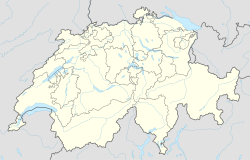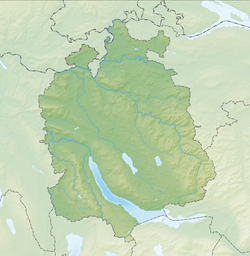Top Qs
Timeline
Chat
Perspective
Winterthur railway station
Railway station in Winterthur, Switzerland From Wikipedia, the free encyclopedia
Remove ads
Winterthur railway station (German: Bahnhof Winterthur) is the principal railway station of the city of Winterthur in the Swiss canton of Zurich,[5] and a major junction station of several railway lines.[1] The station is listed on the Swiss Inventory of Cultural Property of National Significance.[6]
Winterthur is Switzerland's fifth busiest station,[7] and is a major node between Switzerland's largest railway nucleus in Zurich and places in Eastern Switzerland (such as St. Gallen and Schaffhausen), as well as Germany (Konstanz, Munich), and Austria (Bregenz). The station is served by trains on Zurich's suburban S-Bahn network, as well as by InterRegio (IR) and InterCity (IC) and EuroCity (EC) trains, with all through passenger trains making a stop. It is directly linked to Zürich Flughafen – Zurich Airport's railway station – within 15 minutes travelling time seven times per hour. Zürich Hauptbahnhof (Zürich HB) can be reached with up to 16 direct connections per hour, the fastest of which takes 22 minutes. The station has five standard-gauge platforms serving nine tracks and is the central node of the local Stadtbus Winterthur network and regional bus services (e.g. PostBus Switzerland). All public transport in and around Winterthur is part of the Zürcher Verkehrsverbund (ZVV) integrated fare network.[3]
Winterthur is one of ten railway stations in the city of Winterthur (fare zone 120 of ZVV),[3] the others being: Oberwinterthur, Reutlingen, Sennhof-Kyburg, Winterthur Grüze, Winterthur Hegi, Winterthur Seen, Winterthur Töss, Winterthur Wallrüti, and Winterthur Wülflingen.
Remove ads
Location
Bahnhof Winterthur is centrally located, at the northwestern edge of the city centre (Altstadt). To the north of the station are the Red Tower and the ZHAW School of Management and Law.
History
Summarize
Perspective
In 1855, the first temporary station building was built in Winterthur as a timber framed structure. The design of the building was by A. Beck, who also managed the construction. The building was sold in 1860 to the City of Zurich, which wanted to move and rebuild it in the vicinity of the Kornhaus. Most likely, it was used for the construction of the Kornhauswirtschaft, as these two buildings bear a very great resemblance.[8]

Five years after the opening of the provisional building, the first real station was built, under the direction of the architect Jakob Friedrich Wanner, who, together with A. Beck, was responsible for the design. The builder, Meier, came from Winterthur, and the train shed was built by the firm Benkiser of Pforzheim.[9] In 1875, its first expansion was completed, to coincide with the commencement of the Winterthur operations of the Tösstalbahn (lit. 'Töss Valley railway') and the Nationalbahn. This expansion consisted of an extension to each side of the station building equal to the width of four window bays, in order to create space for new waiting rooms.
Further renovations in 1894−96 left the station building in its present form. These renovations, proposed by the architect Ernst Jung and Otto Bridler, produced a station building in Renaissance style; the Federal Palace of Switzerland served as a template.
In 1944, the present day tracks 8 and 9 were added. In 1980, the station was again extended by two tracks (the current platforms 1 and 2), which were used for the Tösstal line and for postal trains. Today, S-Bahn trains to Wil depart from the Postal train track.
In 1988, the two-storey parking deck was built over the station yard. In 2000 followed the construction of the Stadttor Winterthur between the station building and the EPA department store, which is now a Coop City department store.
The term Hauptbahnhof (lit. 'main railway station'), or short HB, for Winterthur railway station is no longer used by Swiss Federal Railways (SBB CFF FFS), the station's owner and operator, but is still sometimes used colloquially. Although the station's name appears simply as "Winterthur" on the station signs and on schedule information, the name Hauptbahnhof is still used for the bus stop in front of the station.
Remove ads
Layout
Winterthur is a through station with five platforms and nine tracks (German: Gleis). Tracks 1 and 2 terminate on the east side of the station, while the remaining tracks run through. The platform nearest the station is a side platform serving track 1 only, while the next nearest platform faces both the terminating track 2 and the through-running track 3. This arrangement is similar to a bay platform; platforms that a physically adjacent to station building are called Hausperron. Three island platforms serve tracks 4–9.[10][11]
In front of the station, on the line towards Zurich, is the former goods station. It was closed in 1995–1996, and serves today only for the storage of trains. As a replacement for the closed structure, a maintenance facility was built at Oberwinterthur railway station.[clarification needed]
Services
Summarize
Perspective
Winterthur is an intermediate stop of several national and international long-distance trains running under the EuroCity, InterCity and InterRegio categories. It is also a major hub for S-Bahn trains of the Zurich S-Bahn network. On weekends (Friday and Saturday nights), there are also four Nighttime S-Bahn services (SN1, SN3, SN6, SN41) offered by ZVV,[12] and two nighttime S-Bahn services (SN22, SN30) offered by the Ostwind fare network.[13] As of the December 2022 timetable change,[update] the following services stop at Winterthur:[14]
- EuroCity (EC): service every two hours between Zürich HB and München Hbf, via Bregenz (runs as ECE 88 in Germany).
- InterCity:
 /
/  : half-hourly service between Geneva Airport or Lausanne and St. Gallen, via Zürich HB; hourly service to Rorschach.
: half-hourly service between Geneva Airport or Lausanne and St. Gallen, via Zürich HB; hourly service to Rorschach. /
/  : hourly service between Spiez and Romanshorn, via Zürich HB; service every two hours from Spiez to Brig and Interlaken Ost.
: hourly service between Spiez and Romanshorn, via Zürich HB; service every two hours from Spiez to Brig and Interlaken Ost.
- InterRegio:
- Zurich S-Bahn:
- S7: half-hourly service to Rapperswil via Zürich HB.
- S8: half-hourly service to Pfäffikon SZ via Zürich HB.
- S11: half-hourly service to Aarau via Zürich HB, and hourly service to either Seuzach or Sennhof-Kyburg (rush-hour service continues to Wila).
- S12: half-hourly service to Brugg AG via Zürich HB, and hourly service to Schaffhausen or Wil.
- S23: peak-hour service between Zürich HB and Romanshorn via Zürich Stadelhofen.
- S24: half-hourly service to Zug via Zürich HB, and hourly service to Thayngen or Weinfelden.
- S26: half-hourly service to Rüti ZH.
- S29: half-hourly service to Stein am Rhein.
- S30: hourly service to Weinfelden (combined with the S24 for half-hourly service).
- S33: hourly service to Schaffhausen (combined with the S12 and S24 for service every 20 minutes).
- S35: hourly service to Wil (combined with the S12 for half-hourly service).
- S41: half-hourly service to Bülach.
- Nighttime S-Bahn (only during weekends):[12]
- SN1: hourly service to Aarau (via Zürich HB).
- SN3: hourly service to Stein am Rhein (via Andelfingen and Schaffhausen).
- SN6: hourly service to Würenlos (via Zürich HB).
- SN41: hourly service to Bülach (via Embrach-Rorbas).
- St. Gallen S-Bahn (limited service):[13]
- SN22: hourly service to St. Margrethen (via Wil SG).
- SN30: hourly service to Romanshorn (via Weinfelden).
Remove ads
Urban public transport
Summarize
Perspective
Winterthur is the central bus station of the local Stadtbus Winterthur bus operator[2] and therefore also the most important hub of the Winterthur trolleybus system. All but two of the city bus lines stop at the forecourt of Winterthur raiilway station ("Hauptbahnhof", abbreviated to "HB" below). Additionally, several regional Stadtbus (lit. 'City Bus') lines, along with PostAuto lines, all stop there. Only the lines that serve Wiesendangen and a few villages northeast of Winterthur depart from Oberwinterthur station instead, while line 9 departs from Winterthur Seen.
Stadtbus Winterthur
Lines 1–3 are trolleybus lines. The remaining lines are operated exclusively by low-floor buses. Normally, articulated buses run on lines 5, 7 and 14. On the remaining lines, conventional (rigid chassis) buses provide the services. All operate within fare zone 120 of ZVV, except line 7 to Elsau (fare zone 164).[3]
As of the December 2023 timetable change,[update] the following routes serve Winterthur railway station:[10]
Regional lines
The yellow numbers are PostAuto lines, and the blue numbers are Stadtbus Winterthur bus lines:[10]
Nighttime buses
Several nighttime bus (German: Nachtbus) lines are operated hourly on Friday to Saturday and Saturday to Sunday from 01:30 to 04:30. As the last regular buses usually depart from HB at 0.50 and the first such buses start running again from 05:30, one can therefore speak of a continuously operating network when the nighttime buses are running.
The nighttime buses operate on the following lines, but only outwards; there are no return services.
Remove ads
Panorama
See also
References
External links
Wikiwand - on
Seamless Wikipedia browsing. On steroids.
Remove ads






